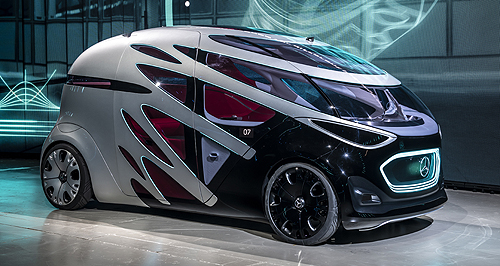Make / Model Search
News - Mercedes-BenzAutonomy the biggest challenge for Mercedes-BenzTough ask: Full autonomy is Mercedes’ most difficult technical challenge yet, according to Ola Kaellenius. Kaellenius pegs autonomous driving as most difficult task going forward for Mercedes20 May 2019 By ROBBIE WALLIS in OSLO INCOMING head of Mercedes-Benz Cars and Daimler AG chairman of the board of management Ola Kaellenius has listed fully autonomous driving as possibly the biggest challenge for the company going forward in a time of vast change in the automotive industry.
Speaking to Australian journalists at the global first drive of the new EQC all-electric SUV in Oslo, Mr Kaellenius said the prospect of creating a self-driving vehicle capable of Level 4 and Level 5 autonomy was arguably the largest engineering problem the company has ever faced.
“The topic of autonomous drive … is surely from a technical point of view the most sophisticated technical problem that we’ve ever tried to solve if you look at all the way to a Level 4/5 robotaxi-like thing for a chaotic city,” he said.
Mr Kaellenius added that the change in the way mobility services are viewed with the advent of autonomy would also have a profound effect on the automotive industry.
“That one has – perhaps in the long term – the biggest disruption potential because in a shared scenario, and that’s the fourth trend – mobility services – that would significantly lower the cost per mile,” he said.
“And every time when you have a good or a service where the cost curve gets parallel-shifted downwards, something usually happens with the demand.”
With some manufacturers making claims of full autonomous driving capability in coming years, Mr Kaellenius took a more cautious approach, saying that full autonomy for the three-pointed star brand was still a way off.
An exact timeline has still not been disclosed, however the next step in the process will be introducing Level 3 autonomy on the next-generation S-Class luxury sedan, while a partnership with Bosch can hopefully produce fully autonomous prototypes in the next two to three years.
“After a very large hype at the beginning – not something that we have fuelled in our communication, but we can feel in the general space – there is a level of realism that sets in because when you introduce those systems you have to make sure that they’re safe,” he said. “That is a sophisticated problem to solve, but we’re determined to solve.
“For the past few years we have had two paths going on at the same time within Mercedes.
“One is the development out of the driving assistance systems where Mercedes is a pioneer – really the first driving assistance systems, period, came from us – where we’re now on a sophisticated Level 2-plus systems, and where it’s our intent with the next-generation S-Class to go for Level 3 in a highway scenario.
“For the Level 4, Level 5 robotaxi scenario or maybe hub-to-hub truck-use scenario, we have – as you probably know – a project going on with Bosch where when it will be commercially viable is a little bit unclear at this point in time, but we’re pushing hard technically in the next two to three years to be able to have products that can do it, and then we see how it develops.”
Mr Kaellenius said the transformative state of the automotive industry will create new players in the market, rather than consolidation among manufacturers.
When asked about new players such as Apple and Dyson entering the automotive market with the rise in autonomy, he said the best course of action for Mercedes is to engage in cooperation when there is an opportunity for mutual benefit.
“It’s probably an era for cooperation because of the massive investments that we’re talking about that drives pragmatic and win-win-driven cooperation,” he said.
“It’s not unusual when a business is in transformation for players that were not in that business before seek some opportunity to enter.
“So, we need to look at both traditional competition and potential new competition in this era.”
When asked if he was open to collaborating with Tesla following incumbent Daimler chairman of the board of management Dieter Zetsche’s comments in February that he was interested in collaborating on the electric Sprinter van, Mr Kaellenius said he was open-minded but there were no concrete plans at this stage.
While the introduction of autonomously driven shared mobility services may potentially result in fewer new cars being sold, Mercedes-Benz still sees new-vehicle ownership as being the main driver for its business, with a goal to continue an increase of overall sales.
Mr Kaellenius said the Asian market in particular has huge potential for growth, as the growth of wealth in those countries continues to blossom over the coming decade.
“It’s our goal to build more cars,” he said. “Yes, mobility services are going to be a growing segment of the market, of which on the premium luxury side, we want to have a healthy market share, no doubt.
“If you look into the future, the next 10 years with how the markets develop, the wealth growth develops – especially Asia as a market develop – we believe that in the next 10 years that ownership per se as a business model remains the main business model.
“It is then increasingly complemented by mobility services where we have our own activities, as well, but where we as a business vehicle producer, want to have a healthy market share.”  Read more |
Click to shareMercedes-Benz articlesResearch Mercedes-Benz Motor industry news |












Facebook Twitter Instagram